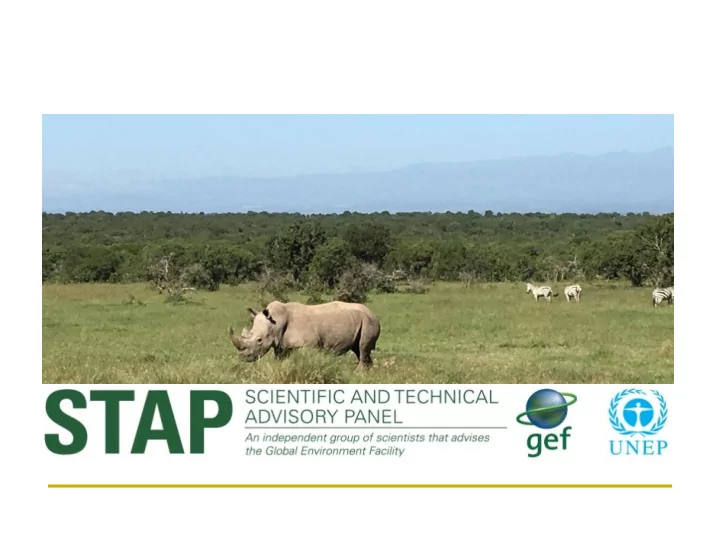

Report to the 51 st Meeting of the GEF Council @STAPGEF
Our Team – October 2016 @STAPGEF
Outline of Presentation New STAP Reports Ongoing Work Issues for GEF Replenishment @STAPGEF
Outline of Presentation New STAP Reports Ongoing Work Issues for GEF Replenishment @STAPGEF
Areas Beyond National Jurisdiction (ABNJ) Key Messages to the GEF Partnership: • Enhance knowledge on ABNJ • Support high impact demonstration projects • Support area-based planning and management tools • Build technical capacity amongst with SIDS and LDCs • Support countries to implement existing rights & obligations under UNCLOS @STAPGEF
Monitoring, Evaluation, and Learning for Climate Change Adaptation (moving from M&E to MEL) • Start simply, learn by doing, and plan for change • Allocate sufficient resources for M&E • Explore synergies between adaptation M&E and development M&E • Include a focus on long-term Source: Ivo Dimitrov on Flickr outcomes • Extensive stakeholder engagement from concept through design, implementation, and evaluation @STAPGEF
Outline of Presentation New STAP Reports Ongoing Work Issues for GEF Replenishment @STAPGEF
Observations on the GEF Work Program General Reflections on STAP Recommendations for October Projects 2016 Work Program Screens • STAP is pleased with the overall quality of projects in this work program. • A number of multi-focal area investments are effectively addressing: – Landscape management – Adaptive management – Institutional capacities across sectors @STAPGEF
Socio-Economic Impacts of Protected Areas STAP, with UNDP developing practical guidance for GEF projects related to protected areas. Evaluations by an international research team include: Social Assessment of Protected Areas (SAPA) • Financial – analysis of Park income and expenditure • Economic – examines visitor spending, local employment, donations, etc. • Social – focus groups to assess overall well- being (positive and negative) • Livelihoods – household, governance and capital surveys Livelihoods surveys
Parks can be engines of economic growth • Park covers costs • Generates $30 m benefits BENEFITS $30 M economic activity 2,200 jobs 179 local business created ~$1 M donations ~$3.0 M taxes COSTS ~$3.5 M in park Park budget fees generated $3.5m
STAP is working closely with the GEF Global Wildlife Program (GWP) • Presented at a workshop on community involvement in Illegal Wildlife Trade (IWT) • Participated in the GWP planning meeting with initial 10 Countries • Will further exchange knowledge on combating illegal wildlife trafficking in Hanoi • Will review the theory of change (TOC) for all GWP child projects The quality of the GWP is steadily increasing as Countries and experts continue to share information and expertise
Improving Knowledge Management The practitioner guide will help: • Integrate KM as a key element of project “ theory of c hange” • Apply KM in implementation, through links to RBM and planning for key knowledge products • Monitor and evaluate KM efforts at Source: Jordi G on Flickr closure, and ensure access to knowledge assets @STAPGEF
ENGAGEMENT WITH CONVENTIONS @STAPGEF
UNCCD: Pursuing land degradation neutrality (LDN) • Co-led Scientific Conceptual Framework • The framework presents principles for countries reporting on LDN • Science-Policy Brief released at UNCCD CRIC 15 Nairobi 18-20 October 2016 www.unccd.int/Lists/SiteDocumentLibrary/Publications/10_2016_spi_pb_multipage_eng.pdf @STAPGEF
Mercury Platform Pilot well underway • Created an open, virtual space for sharing of data, knowledge, and communities of practice • Increase opportunities for peer review of data and practice among specialists, national/regional partners • Standardized data protocols; improved ownership & transparency http://pre-uneplive.unep.org/theme/index/16# @STAPGEF
Outline of Presentation New STAP Reports Ongoing Work Issues for GEF Replenishment @STAPGEF
Highlights from STAP’s Report to the 5 th GEF Assembly Environmental degradation must be tackled in a more integrated and holistic way. Sustainable development should be at the core of GEF interventions. The GEF’s core business should be catalytic investments, while actively seeking to effect permanent and transformational change. @STAPGEF
Assessing a changing global policy landscape @STAPGEF
2 16 3 15 4 14 IMPACT planning& CC in planning 13.2.Integrate capacity Finance 13.3.Educati for CC 13.a/b mgmt on on CC and 5 13 9.1/9.4.New &Improved sustainable infrastructu UNFCCC 9a.Support re 12 6 sustainable infrastructur Convention/MEA goal or objective: e To stabilize greenhouse gas development 9.2.Industri alization in concentrations "at a level that would LDCs prevent dangerous anthropogenic (human induced) interference with the climate system." It states that 7 "such a level should be achieved 11 within a time-frame sufficient to allow ecosystems to adapt naturally to climate change, to ensure that food production is not threatened, 10 8 and to enable economic 9 development to proceed in a @STAPGEF sustainable manner."
Thinking Ahead to the Assembly Report 2. How can integration be done in 1. What opportunities arise for the practice, in the context of the GEF? GEF in the new policy landscape ? Source: Thomas Hawk on Flickr 3. What are key emerging issues where STAP can assist the GEF? • Sustainable Consumption and Production • Environmental Security • Novel Entities • Ocean Governance @STAPGEF
Some inputs to STAP’s Assembly Report 2018 • Demonstrate lessons from GEF integration across portfolio and MFAs • GEF’s unique role in financing for innovation, given the changing landscape of funding @STAPGEF
Some insights from the GEF Global Commons Meeting Johan Rockstrom, GEF Global Commons Meeting, October 2016
Some insights from the GEF Global Commons Meeting Reconnecting + World = Development with Global Commons Johan Rockstrom, GEF Global Commons Meeting, October 2016
Good news, Bad news Source: NOAA on Flickr Source: Brian Gratwicke on Flickr @STAPGEF
Good news story - Kihansi Spray Toad @STAPGEF
And, new reserves! Source: NOAA on Flickr Source: kris krüg on Flickr Map credits: NOAA Source: kris krüg on Flickr @STAPGEF
Questions? Source: NOAA on Flickr Source: kris krüg on Flickr Source: kris krüg on Flickr @STAPGEF
Recommend
More recommend